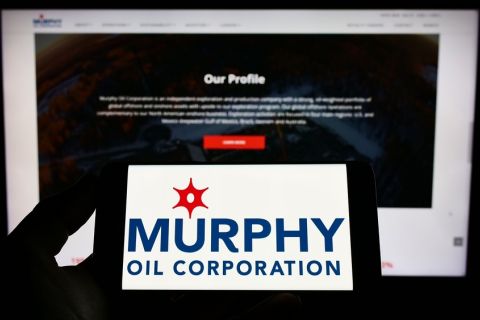
While Encana continues to develop its reserves in the Horn River Basin and Montney shale, the company is ready to begin developing a new liquids-rich play in Canada. The company holds approximately 190,000 acres in the Duvernay shale in west central Canada as part of its program to concentrate on increasing liquids production.
“We’re drilling liquids-prone targets on our existing lands, expanding development into liquids-rich areas, exploring for oil and acquiring large and significant positions of highly prospective liquids-rich lands as well. Of our 2011 capital budget, about $1 billion is directed towards activities that will increase our future liquids recovery,” Randy Eresman, chief executive of Encana, said on a conference call to discuss Q1 2011 earnings.
The company acquired its acreage in the Duvernay shale for roughly $300 million and anticipates that the play could add significant liquids production. Development of the play is early, but it may be similar to the Eagle Ford according to Michael Graham, the company’s executive vice president and president of its Canadian division. “We could go from sort of a dry gas window into a liquids-rich window,” he said with roughly two-thirds of Encana’s acreage in the play being in the liquids-rich portion based on test well results.
Eresman added that increased liquids production may also be increased out of the company’s holdings in the Niobrara and Mancos shales in the DJ basin in Colorado, as well as the Collingwood shale in Michigan.
“By bringing on more oil and NGL production and stripping out more NGLs from our natural gas stream, we expect to significantly increase the weighting of liquids in our portfolio, capturing more value and enhancing returns,” Eresman said. He added that the company is also building more facilities focused on increasing its liquids extraction capacity from these plays as well as other holdings.
Included in this plan to increase liquids production is the company’s recently announced agreement to acquire a 30% interest in the planned Kitimat LNG export terminal in British Columbia. “By investing in this planned international trade facility, we’re helping diversify the markets for North America natural gas toward exporting production for the first time from Canada to overseas markets,” he said.
Much of these exports would be focused on Asia, which is increasing its demand levels for natural gas as seen in the formation of a 50/50 joint venture in the quarter between Encana and a PetroChina subsidiary for Encana’s Cutbank Ridge gas-rich assets in British Columbia and Alberta. Approval for this $5.67-billion agreement is still pending from both Canadian and Chinese authorities, but Encana anticipates further third-party agreements in the future.
“We recently initiated a new process seeking joint venture partners on certain assets in the Horn River and Greater Sierra areas. We’re also offering an acquisition opportunity for a portion of the Jean Marie assets within the Greater Sierra resource play,” Eresman said.
Encana is increasing its focus on liquids due to the persistence of low gas prices. However, the company managed to generate strong earnings in the quarter despite this hindrance. For Q1, Encana posted earnings of $15 million on cash flow of roughly $955 million.
These returns were due to increased production, which was led by growth in Cutbank Ridge--up 40% from the previous year--and the Horn River, which grew from 11 million cubic feet per day (MMcf/d) of production in Q1 2010 to 70 MMcf/d in Q1 2011 as well as the Haynesville, where production increased 118% from the previous year’s quarter. Haynesville production is expected to increase in the second quarter as Encana moves from land retention drilling to resource play hub style drilling.
Capex funding was roughly $1.3 billion in the quarter and the company remains on target to hits its planned total of $4.6 billion to $4.8 billion in spending for the fiscal year. “This capital investment has worked to advance the development of several established and emerging resource plays while at the same time generating production growth. We’re firm believers in the benefits of high-grading our portfolio and are continuously looking for opportunities to divest assets that no longer fit with our future development plans, as well as adding new lands in promising areas,” Eresman said.
In the quarter, the company divested approximately $400 million worth of non-core assets in North America, including the sale of the Fort Lupton natural gas processing plant near Denver, Colorado, to Western Gas Partners for $303 million.
Recommended Reading
Investor Returns Keep Aethon IPO-ready
2024-10-08 - Haynesville producer Aethon Energy is focused on investor returns-- additional bolt-on acquisitions and mainly staying “IPO ready,” the company’s Senior Vice President of Finance said Oct. 3 at Hart Energy’s Energy Capital Conference (ECC) in Dallas.
No Rush: Post-M&A Frenzy, Divestiture Market to Pick Up by 2025
2024-10-07 - Lenders with a variety of capital structures are poised to fund the upcoming portfolio rationalization in the post-consolidation era, bankers and deal advisers said at Hart Energy’s Energy Capital Conference.
Tellurian Stockholders Approve $900MM Woodside Acquisition
2024-10-07 - Woodside Energy has said it expects to close the acquisition of Tellurian, and its Driftwood LNG permitted facility, by December.
Murphy Oil Names New CEO, Adds Two Directors to Board
2024-10-06 - Murphy Oil’s current COO Eric M. Hambly has been appointed to CEO and president, succeeding Roger W. Jenkins. The board also added Hambly and Robert B. Tudor III as new directors.
Utica Oil E&P Infinity Natural Resources Latest to File for IPO
2024-10-05 - Utica Shale E&P Infinity Natural Resources has not yet set a price or disclosed the number of shares it intends to offer.
Comments
Add new comment
This conversation is moderated according to Hart Energy community rules. Please read the rules before joining the discussion. If you’re experiencing any technical problems, please contact our customer care team.





